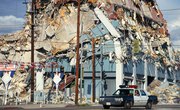
When one side of a transform boundary moves north and the other south, like with the San Andreas fault, the ground moves and rumbles, shaking everything within the path of its reach. On transform boundaries, sometimes the ground opens, creating a small valley, a depression forms, ponds drain or fill, or you can see a clear split between the two tectonic plates, as in the asphalt roads that cross the fault line. Earthquakes affect people, land and nature in distinctive ways.
TL;DR (Too Long; Didn't Read)
The surface of Earth is broken into seven distinct major plates, and several minor ones, that inform scientists about where earthquakes might happen. Where the edges of these giant puzzle-like pieces meet, specific boundaries form. The three boundaries -- transform, convergent and divergent -- define what happens on land, nature and to people during an earthquake.
Land Changes
When two massive plates meet at a convergent boundary, the impact buckles one or both edges of the plates, shifting them upwards to create mountains and sometimes volcanoes – or it can bend one of the plates to create a deep marine trench on the seabed. In divergent boundaries, the plates move away from each other on the ocean’s floor, often forming deep trenches that allow magma fissures to open and spew lava.
Liquefaction and Landslides
Everything within the reach of an earthquake, depending on its strength and intensity, are affected by an earthquake’s seismic waves that move out in concentric rings from the epicenter of the event. The ground’s makeup determines how fast or slow these waves move. Silt and sand, as found on coastlines or in landfill areas tend to become fluid, moving and shaking very rapidly and cause buildings built in these areas to tumble and fall. Loose scrabble during the shaking leads to landslides where dirt, rock and debris tumble down the side of a mountain or hill.
The Tsunamis That Follow
Along the Pacific Northwest Coast west of Eureka, California, and all the way up into British Columbia runs the 750-mile long Cascadia fault where multiple plates meet to create three boundaries, a deadly combination that could lead to a sustained 5-minute long earthquake of with a 9 on the Richter scale. Besides the damage from the massive earthquake, about 20 to 30 minutes after the earthquake, a massive wave, created by the movement and landslides along the coast will cause even more damage, like that experienced in the 9.1 earthquake off the coast of Japan in 2011. Ken Murphy, a FEMA expert noted in 2015 the effects of the earthquake in Oregon and Washington, “Our operating assumption is that everything west of Interstate 5 will be toast,” due to the one-two punch of the earthquake and tsunami.
Physical and Psychological Effects
People that don’t have emergency plans in place might end up getting trapped, injured or even killed because of the aftermath of an earthquake. Even when people don’t get hurt by an earthquake, it can still have lasting effects on the psyche. After serious trauma of any kind, some people may end up with Post Traumatic Stress Disorder that affects them years after a damaging earthquake occurs.
References
About the Author
Christian Mullen is a graduate from the University of Central Florida with a bachelor's degree in finance. He has written content articles online since 2009, specializing in financial topics. A professional musician, Mullen also has expert knowledge of the music industry and all of its facets.
